All-Fiber LITES Sensor Based on Hollow-Core Anti-Resonant Fiber and Self-Designed Low-Frequency Quartz Tuning Fork
Abstract
1. Introduction
2. Experimental Setup
2.1. Characteristics of HC-ARF and Self-Designed QTF
2.2. HC-ARF-Based LITES Sensor Structure
3. Experimental Results and Discussion
4. Conclusions
Author Contributions
Funding
Institutional Review Board Statement
Informed Consent Statement
Data Availability Statement
Conflicts of Interest
References
- Liu, K.; Wang, L.; Tan, T.; Wang, G.; Zhang, W.; Chen, W.; Gao, X. Highly sensitive detection of methane by near-infrared laser absorption spectroscopy using a compact dense-pattern multipass cell. Sens. Actuators B Chem. 2015, 220, 1000–1005. [Google Scholar] [CrossRef]
- Wang, R.; Qiao, S.; He, Y.; Ma, Y. Highly sensitive laser spectroscopy sensing based on a novel four-prong quartz tuning fork. Opto-Electron. Adv. 2025, 8, 240275. [Google Scholar] [CrossRef]
- Zifarelli, A.; Sampaolo, A.; Patimisco, P.; Giglio, M.; Gonzalez, M.; Wu, H.; Dong, L.; Spagnolo, V. Methane and ethane detection from natural gas level down to trace concentrations using a compact mid-IR LITES sensor based on univariate calibration. Photoacoustics 2023, 29, 100448. [Google Scholar] [CrossRef] [PubMed]
- Wang, G.; Cui, R.; Di, J.; Wang, J.; Wang, Y.; Shang, Z.; Liu, X.; Tian, Q.; Wu, H.; Dong, L. Portable methane sensor system using miniature multi-pass cell for mobile monitoring of natural gas leaks. Sens. Actuators B Chem. 2025, 431, 137457. [Google Scholar] [CrossRef]
- Zifarelli, A.; Negro, G.; Mongelli, L.A.; Sampaolo, A.; Ranieri, E.; Dong, L.; Wu, H.; Patimisco, P.; Gonnella, G.; Spagnolo, V. Effect of gas turbulence in quartz-enhanced photoacoustic spectroscopy: A comprehensive flow field analysis. Photoacoustics 2024, 38, 100625. [Google Scholar] [CrossRef]
- Mei, H.; Wang, G.; Xu, Y.; He, H.; Yao, J.; He, S. Simultaneous measurement of methane, propane and isobutane using a compact mid-infrared photoacoustic spectrophone. Photoacoustics 2024, 39, 100635. [Google Scholar] [CrossRef]
- Qiao, S.D.; He, Y.; Sun, H.Y.; Patimisco, P.; Sampaolo, A.; Spagnolo, V.; Ma, Y.F. Ultra-highly sensitive dual gases detection based on photoacoustic spectroscopy by exploiting a long-wave, high-power, wide-tunable, single-longitudinal-mode solid-state laser. Light Sci. Appl. 2024, 13, 100. [Google Scholar] [CrossRef]
- Wang, X.; Qiu, X.; Liu, M.; Liu, F.; Li, M.; Xue, L.; Chen, B.; Zhang, M.; Xie, P. Flat soliton microcomb source. Opto-Electron. Sci. 2023, 2, 230024. [Google Scholar] [CrossRef]
- Sun, B.; Patimisco, P.; Sampaolo, A.; Zifarelli, A.; Spagnolo, V.; Wu, H.; Dong, L. Light-induced thermoelastic sensor for ppb-level H2S detection in a SF6 gas matrices exploiting a mini-multi-pass cell and quartz tuning fork photodetector. Photoacoustics 2023, 33, 100553. [Google Scholar] [CrossRef]
- Ran, S.X.; Ni, W.J.; Yang, C.Y.; Zhao, Z.K.; Lin, Q.S.; He, B.Z.; Wu, R.M.; Shum, P.P. Fiber-tip photothermal transducer with gold-coated multi-beam interferometric cavity for high sensitivity gas detection. Appl. Phys. Lett. 2025, 126, 062201. [Google Scholar] [CrossRef]
- Wang, Y.; Zhang, J.; Zheng, Y.; Xu, Y.; Xu, J.; Jiao, J.; Su, Y.; Lü, H.-F.; Liang, K. Brillouin scattering spectrum for liquid detection and applications in oceanography. Opto-Electron. Adv. 2023, 6, 220016. [Google Scholar] [CrossRef]
- Shao, M.; Ji, C.; Tan, J.; Du, B.; Zhao, X.; Yu, J.; Man, B.; Xu, K.; Zhang, C.; Li, Z. Ferroelectrically modulate the Fermi level of graphene oxide to enhance SERS response. Opto-Electron. Adv. 2023, 6, 230094. [Google Scholar] [CrossRef]
- Zhang, C.; Qiao, S.; He, Y.; Liu, C.; Ma, Y. Multi-resonator T-type photoacoustic cell based photoacoustic spectroscopy gas sensor for simultaneous measurement C2H2, CH4 and CO2. Sens. Actuators B Chem. 2025, 427, 137168. [Google Scholar] [CrossRef]
- Li, T.; Zhao, P.; Wang, P.; Krishnaiah, K.V.; Jin, W.; Zhang, A.P. Miniature optical fiber photoacoustic spectroscopy gas sensor based on a 3D micro-printed planar-spiral spring optomechanical resonator. Photoacoustics 2024, 40, 100657. [Google Scholar] [CrossRef]
- Han, X.; Li, C.; Qi, H.; Peng, W.; Chen, K. Carbon black absorption enhanced fiber-optic photoacoustic gas sensing system with ultrahigh sensitivity. Anal. Chem. 2025, 97, 2518–2524. [Google Scholar] [CrossRef]
- Lou, C.; Li, X.; Chen, H.; Yang, X.; Zhang, Y.; Yao, J.-Q.; Liu, X. Polymer-coated quartz tuning fork for enhancing sensitivity of laser-induced thermoelastic spectroscopy. Opt. Express 2021, 29, 12195–12205. [Google Scholar] [CrossRef]
- Feng, C.; Shen, X.; Li, B.; Liu, X.; Jing, Y.; Huang, Q.; Patimisco, P.; Spagnolo, V.; Dong, L.; Wu, H. Carbon monoxide impurities in hydrogen detected with resonant photoacoustic cell using a mid-IR laser source. Photoacoustics 2024, 36, 100585. [Google Scholar] [CrossRef]
- Wang, L.; Lv, H.; Zhao, Y.; Wang, C.; Luo, H.; Lin, H.; Xie, J.; Zhu, W.; Zhong, Y.; Liu, B.; et al. Sub-ppb level HCN photoacoustic sensor employing dual-tube resonator enhanced clamp-type tuning fork and U-net neural network noise filter. Photoacoustics 2024, 38, 100629. [Google Scholar] [CrossRef]
- Zhang, F.C.; Camarero, P.; Haro-González, P.; Labrador-Páez, L.; Jaque, D. Optical trapping of optical nanoparticles: Fundamentals and applications. Opto-Electron. Sci. 2023, 2, 230019. [Google Scholar] [CrossRef]
- Wang, J.P.; Wu, H.P.; Liu, X.L.; Wang, G.; Wang, Y.; Feng, C.F.; Cui, R.Y.; Dong, L. Cantilever-enhanced dual-comb photoacoustic spectroscopy. Photoacoustics 2024, 38, 100605. [Google Scholar] [CrossRef]
- S Russo, S.D.; Pelini, J.; Garcia, I.L.; Canino, M.C.; Roncaglia, A.; Pastor, P.C.; Galli, I.; De Natale, P.; Borri, S.; de Cumis, M.S. Dual-tube MEMS-based spectrophone for sub-ppb mid-IR photoacoustic gas detection. Photoacoustics 2024, 40, 100644. [Google Scholar] [CrossRef] [PubMed]
- Sun, H.Y.; He, Y.; Qiao, S.D.; Liu, Y.H.; Ma, Y.F. Highly sensitive and real-simultaneous CH4/C2H2 dual-gas LITES sensor based on Lissajous pattern multi-pass cell. Opto-Electron. Sci. 2024, 3, 240013. [Google Scholar] [CrossRef]
- Sun, H.; Qiao, S.; He, Y.; Sun, X.; Ma, Y. Parts-per-quadrillion level gas molecule detection: CO-LITES sensing. Light Sci. Appl. 2025, 14, 180. [Google Scholar] [CrossRef]
- Shang, Z.; Wu, H.; Wang, G.; Cui, R.; Li, B.; Gong, T.; Guo, G.; Qiu, X.; Li, C.; Dong, L. Robust and compact light-induced thermoelastic sensor for atmospheric methane detection based on a vacuum-sealed subminiature tuning fork. Photoacoustics 2025, 42, 100691. [Google Scholar] [CrossRef]
- Wang, Z.; Nie, Q.X.; Sun, H.J.; Wang, Q.; Borri, S.; Natale, P.D.; Ren, W. Cavity-enhanced photoacoustic dual-comb spectroscopy. Light Sci. Appl. 2024, 13, 11. [Google Scholar]
- Li, A.; Wu, Y.; Wang, C.; Bao, F.; Yang, Z.; Pan, S. An inversely designed integrated spectrometer with reconfigurable performance and ultra-low power consumption. Opto-Electron. Adv. 2024, 7, 240099. [Google Scholar] [CrossRef]
- Cheng, Y.; Xu, Y.; Chen, T.; Mei, H.; He, S. Differential laser-induced thermoelastic spectroscopy for dual-gas CO2/CH4 detection. Measurement 2025, 240, 115594. [Google Scholar] [CrossRef]
- Zhang, H.; Wang, Z.; Wang, Q.; Borri, S.; Galli, I.; Sampaolo, A.; Patimisco, P.; Spagnolo, V.L.; De Natale, P.; Ren, W. Parts-per-billion-level detection of hydrogen sulfide based on doubly resonant photoacoustic spectroscopy with line-locking. Photoacoustics 2023, 29, 100436. [Google Scholar] [CrossRef]
- Li, S.; Yuan, Y.; Shang, Z.; Yin, X.; Sampaolo, A.; Patimisco, P.; Spagnolo, V.; Dong, L.; Wu, H. Ppb-level NH3 photoacoustic sensor combining a hammer-shaped tuning fork and a 9.55 µm quantum cascade laser. Photoacoustics 2023, 33, 100557. [Google Scholar] [CrossRef]
- Golmohamadi, H.; Keypour, R.; Mirzazade, P. Multi-objective co-optimization of power and heat in urban areas considering local air pollution. Eng. Sci. Technol. Int. J. 2021, 24, 372–383. [Google Scholar] [CrossRef]
- Y Ma, Y.; Sui, X.; Song, F.; Chang, Z.; Zhang, Y.; Zheng, C.; Wang, Y.; Tittel, F.K. Optical-domain modulation cancellation method for background-suppression and dual-gas detection in light-induced thermo-elastic spectroscopy. Sens. Actuators B Chem. 2024, 404, 135168. [Google Scholar] [CrossRef]
- Zhou, T.; Wu, T.; Wu, Q.; Chen, W.D.; Wu, M.W.; Ye, C.W.; He, X.D. Real-time monitoring of 13C-and 18O-isotopes of human breath CO2 using a mid-infrared hollow waveguide gas sensor. Anal. Chem. 2020, 92, 12943–12949. [Google Scholar] [CrossRef] [PubMed]
- Zhang, D.; Zhang, H.; Fan, H.; Hu, M.; Wang, H.; Zhou, J.; Lv, J.; Liang, J.; Wang, Q. Cavity-enhanced light-induced thermoelastic spectroscopy for trace-gas sensing. Opt. Express 2024, 32, 33618–33627. [Google Scholar] [CrossRef] [PubMed]
- Ma, Y.; Liu, Y.; He, Y.; Qiao, S.; Sun, H. Design of multipass cell with dense spot patterns and its performance in a light-induced thermoelastic spectroscopy-based methane sensor. Light Adv. Manuf. 2025, 6, 1. [Google Scholar] [CrossRef]
- Li, Z.; Chen, J.; Li, L.; Zhang, J.; Yao, J. Exceptional-point-enhanced sensing in an all-fiber bending sensor. Opto-Electron. Adv. 2023, 6, 230019. [Google Scholar] [CrossRef]
- Hu, L.; Zheng, C.; Zhang, Y.; Zheng, J.; Wang, Y.; Tittel, F.K. Compact all-fiber light-induced thermoelastic spectroscopy for gas sensing. Opt. Lett. 2020, 45, 1894–1897. [Google Scholar] [CrossRef]
- Ma, Y.; Feng, W.; Qiao, S.; Zhao, Z.; Gao, S.; Wang, Y. Hollow-core anti-resonant fiber based light-induced thermoelastic spectroscopy for gas sensing. Opt. Express 2022, 30, 18836–18844. [Google Scholar] [CrossRef]
- Gomółka, G.; Pysz, D.; Buczyński, R.; Nikodem, M. Wavelength modulation spectroscopy of oxygen inside anti-resonant hollow-core fiber-based gas cell. Opt. Laser Technol. 2024, 170, 110323. [Google Scholar] [CrossRef]
- Bojęś, P.; Jaworski, P.; Pokryszka, P.; Belardi, W.; Spagnolo, V.; Krzempek, K. Dual- band light-induced thermoelastic spectroscopy utilizing an antiresonant hollow-core fiber-based gas absorption cell. Appl. Phys. B 2023, 129, 177. [Google Scholar] [CrossRef]
- Jiang, S.; Chen, F.; Zhao, Y.; Gao, S.; Wang, Y.; Ho, H.L.; Jin, W. Broadband all-fiber optical phase modulator based on photo-thermal effect in a gas-filled hollow-core fiber. Opto-Electron. Adv. 2023, 6, 220085. [Google Scholar] [CrossRef]
- Liu, Z.; Dong, S.; Zhang, L.; Liu, H.; Zhou, Z.; Dong, Y.; Yang, T. Exhaustive design and statistical analysis of HC-ARFs based on geometric modeling. J. Light. Technol. 2024, 42, 5293–5301. [Google Scholar] [CrossRef]
- Jing, Y.; Du, H.; Hua, J.; Li, X.; Li, J.; Li, S. Polarization filter of hollow-core anti-resonant fiber in the 1550 nm band based on SPR effect. Opt. Laser Technol. 2025, 180, 111407. [Google Scholar] [CrossRef]
- Pei, S.; Nie, Q.; Liu, Z.; Cheng, M.; Yang, D.; Wang, Y.; Gao, S.; Cheng, C.; Guo, D.; Yang, M. Atmospheric environment monitoring by antiresonant fiber-enhanced Raman Spectroscopy with sub-ppm sensitivity. IEEE Sens. J. 2024, 24, 34604–34610. [Google Scholar] [CrossRef]
- Z Zhang, Z.; Zhou, M.; Wang, C.; Wang, Y.; Guo, X.; Zhou, C.; Ruan, S. Temperature-immune Fabry-Perot cavity sensor based on an opened hollow-core anti-resonant fiber. Opt. Express 2023, 31, 5483–5491. [Google Scholar] [CrossRef]
- Li, Y.; Chen, H.; Chen, Q.; Li, H.; Gao, Z. Surface plasmon resonance induced methane gas sensor in hollow core anti-resonant fiber. Opt. Fiber Technol. 2023, 78, 103293. [Google Scholar] [CrossRef]
- Bi, S.; Zhang, X.; Zhang, Z.; Liu, X.; Qin, L.; Shi, J.; Zhao, Y.; Wang, Z. A light-induced thermoelastic spectroscopy using surface mounted device quartz tuning fork. Photoacoustics 2025, 42, 100686. [Google Scholar] [CrossRef]
- Chen, X.; Qu, R.; Liu, H.; Yao, L.; Xu, Z.; Hu, M.; Wang, W.; Kan, R. MXene-coated quartz tuning fork for sensitive light-induced thermoelastic spectroscopy. Opt. Express 2025, 33, 1394–1405. [Google Scholar] [CrossRef]
- Erbaş, K.C.; Erdoğan, M.; Serdaroğlu, D.Ç.; Koçum, I.C. A game-changing equation during the etching of tuning forks and its verification through experiments. Measurement 2024, 237, 115135. [Google Scholar] [CrossRef]
- C Feng, C.; Zifarelli, A.; Menduni, G.; Sampaolo, A.; Wu, H.; Dong, L.; Spagnolo, V.; Patimisco, P. Low frequency quartz tuning fork as hydrogen sensor. Int. J. Hydrogen Energ. 2024, 96, 763–770. [Google Scholar] [CrossRef]
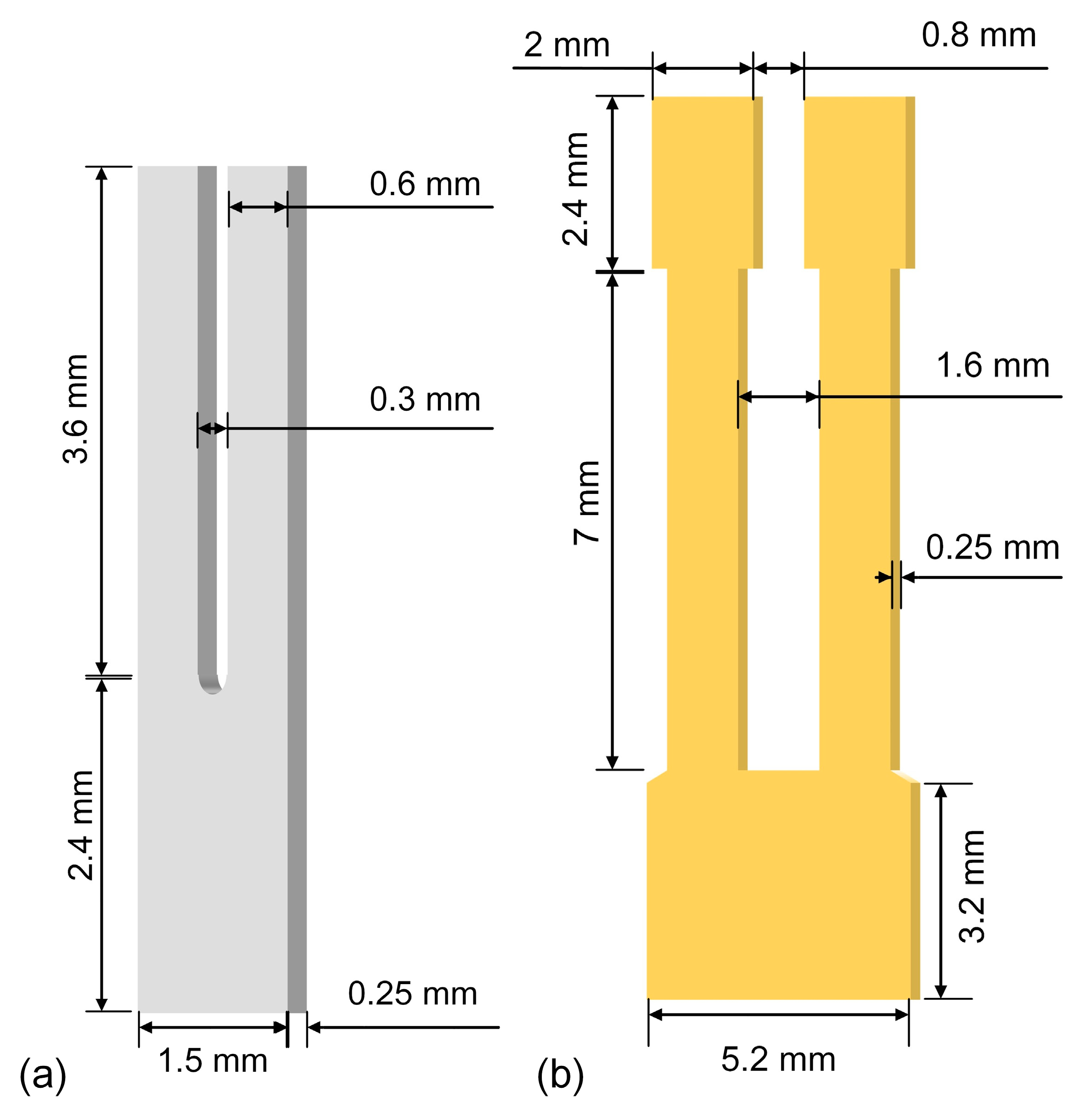

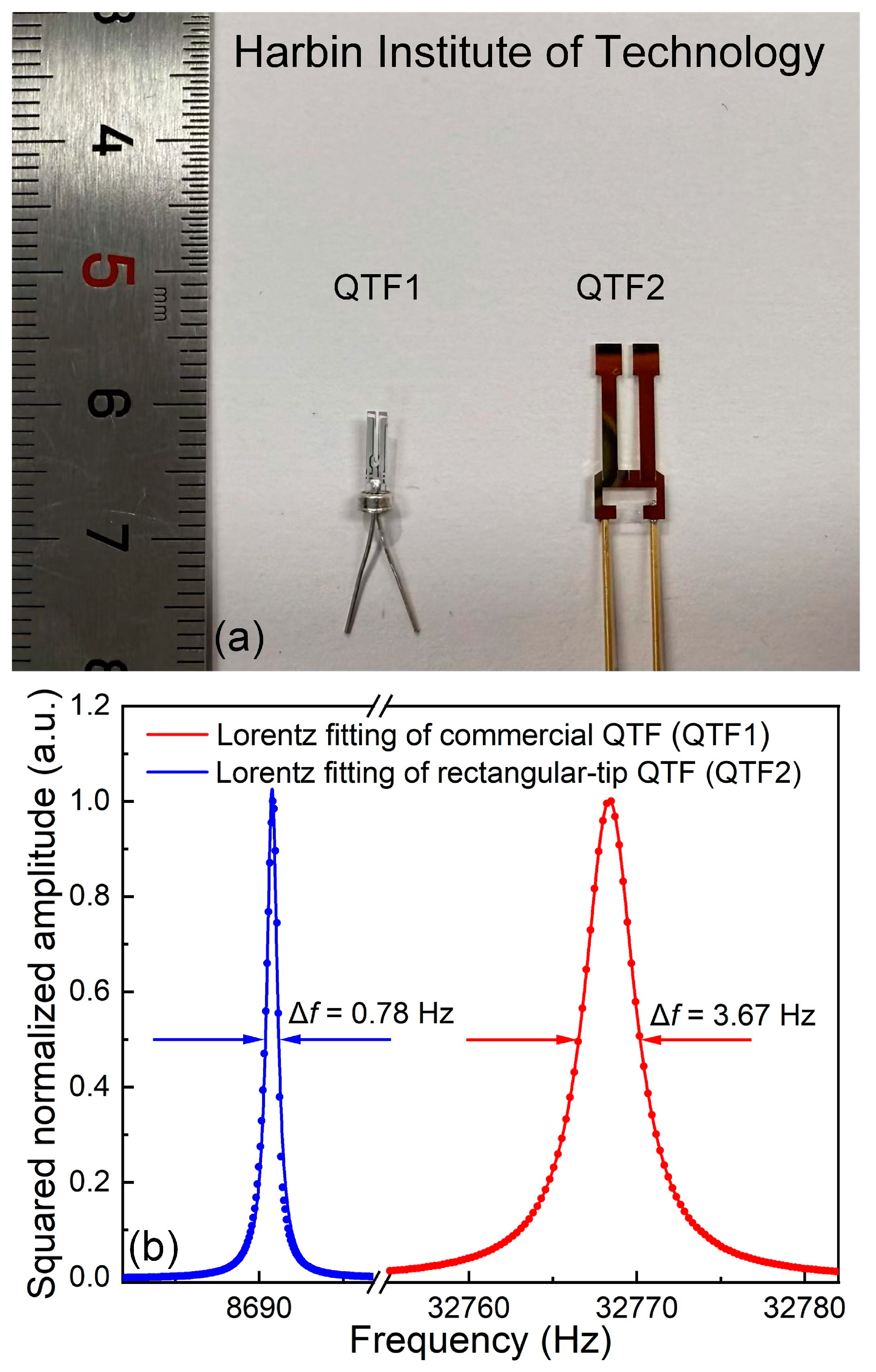
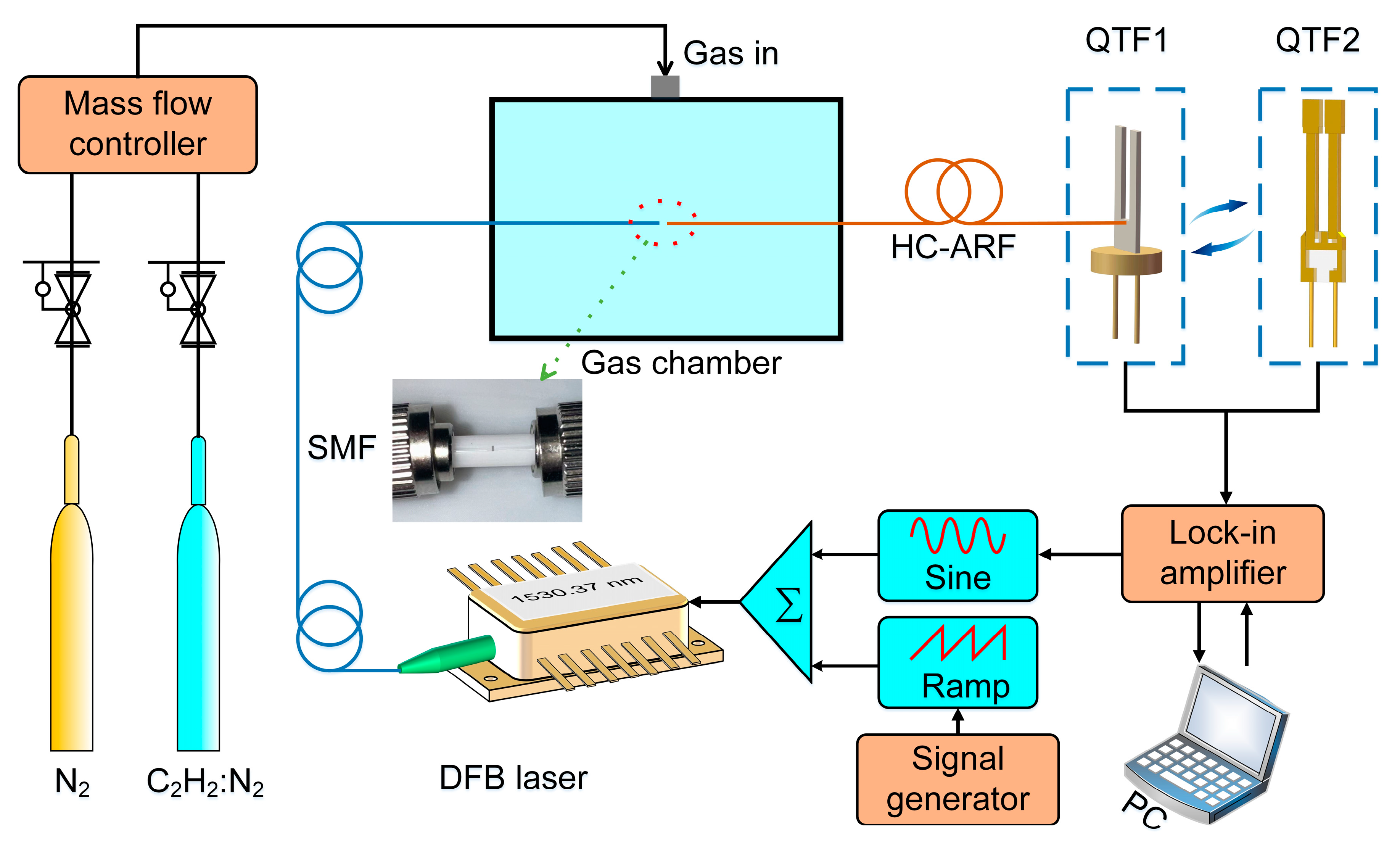


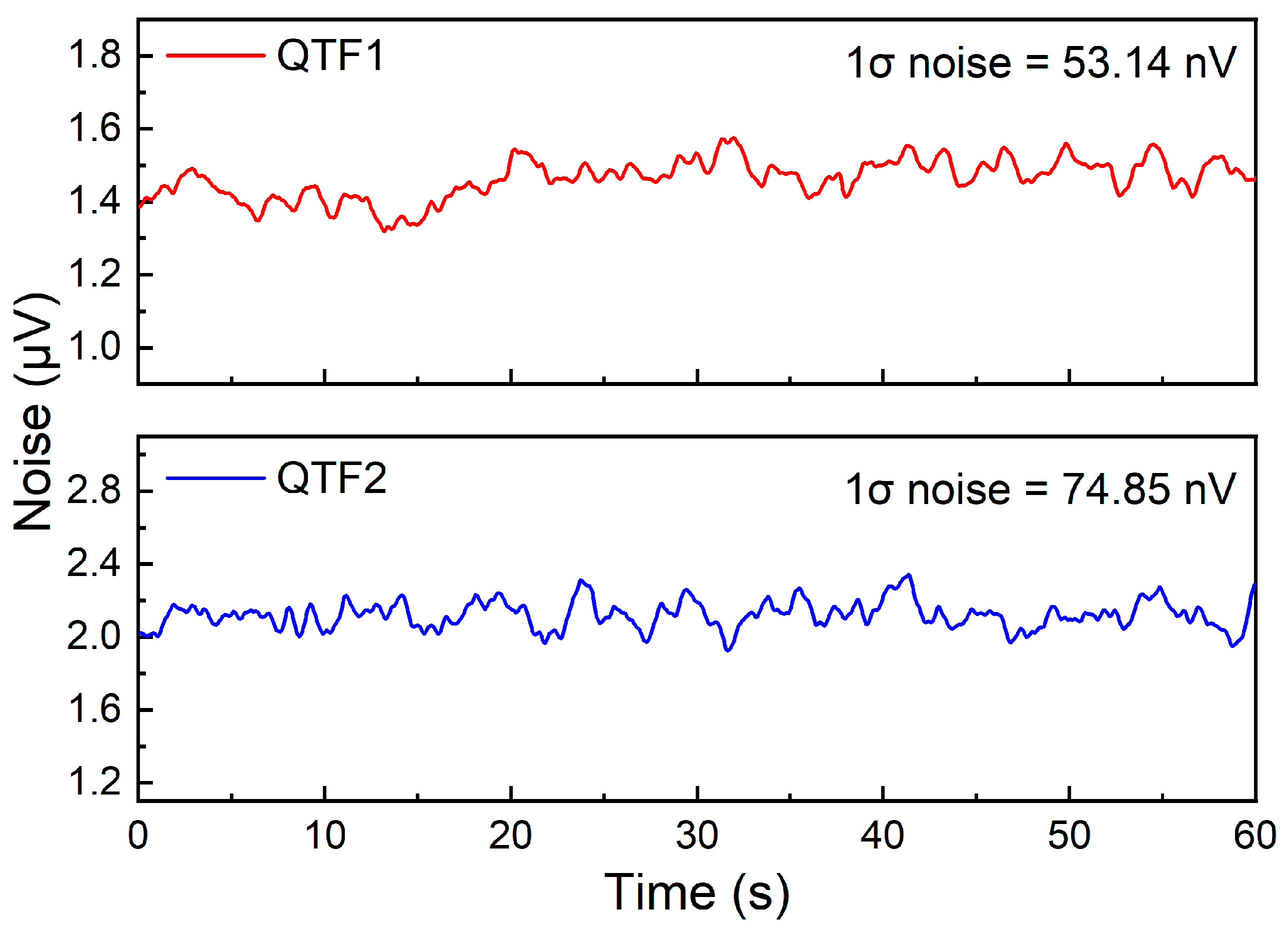
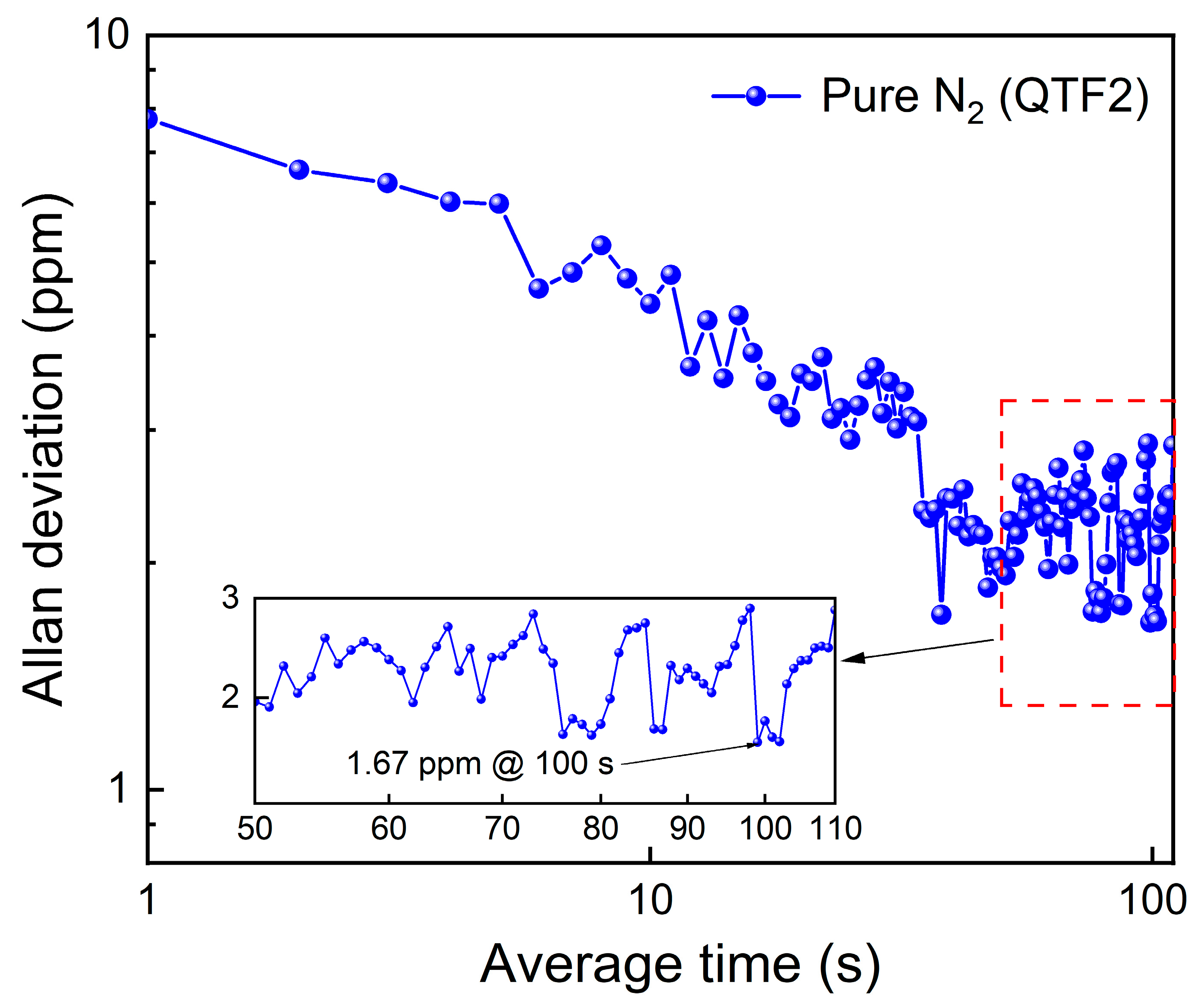
Disclaimer/Publisher’s Note: The statements, opinions and data contained in all publications are solely those of the individual author(s) and contributor(s) and not of MDPI and/or the editor(s). MDPI and/or the editor(s) disclaim responsibility for any injury to people or property resulting from any ideas, methods, instructions or products referred to in the content. |
© 2025 by the authors. Licensee MDPI, Basel, Switzerland. This article is an open access article distributed under the terms and conditions of the Creative Commons Attribution (CC BY) license (https://creativecommons.org/licenses/by/4.0/).
Share and Cite
Sun, X.; Chen, W.; He, Y.; Sun, H.; Qiao, S.; Ma, Y. All-Fiber LITES Sensor Based on Hollow-Core Anti-Resonant Fiber and Self-Designed Low-Frequency Quartz Tuning Fork. Sensors 2025, 25, 2933. https://doi.org/10.3390/s25092933
Sun X, Chen W, He Y, Sun H, Qiao S, Ma Y. All-Fiber LITES Sensor Based on Hollow-Core Anti-Resonant Fiber and Self-Designed Low-Frequency Quartz Tuning Fork. Sensors. 2025; 25(9):2933. https://doi.org/10.3390/s25092933
Chicago/Turabian StyleSun, Xiaorong, Weipeng Chen, Ying He, Haiyue Sun, Shunda Qiao, and Yufei Ma. 2025. "All-Fiber LITES Sensor Based on Hollow-Core Anti-Resonant Fiber and Self-Designed Low-Frequency Quartz Tuning Fork" Sensors 25, no. 9: 2933. https://doi.org/10.3390/s25092933
APA StyleSun, X., Chen, W., He, Y., Sun, H., Qiao, S., & Ma, Y. (2025). All-Fiber LITES Sensor Based on Hollow-Core Anti-Resonant Fiber and Self-Designed Low-Frequency Quartz Tuning Fork. Sensors, 25(9), 2933. https://doi.org/10.3390/s25092933






